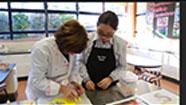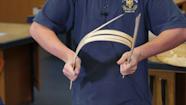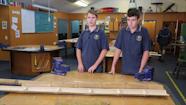Julie Clement considers how resources influence the authentic experiences for her students.
Resourcing for a digital and design focus
Transcript
Julie Clement: We moved to a space that was a generic teaching space with no equipment. The focus really was to link in with the resources that I had, the design community, the universities, technology experts, to deliver these authentic programmes that would really engage the girls, and the parents, and our learning community.
So when I’m thinking about equipment for this area, budget obviously is a big consideration. We make decisions about purchasing equipment that is small and portable, so it will fit in within our space, and also is cost effective, and it can then be replaced – equipment like 3D printers, vinyl cutters.
We take opportunities when there is equipment available that really relates to the industry. We bought the Gerber pattern technology system when a factory was closing down. We’ve made this conscious decision and it’s really supported by the school because we can outsource. We outsource for the big equipment because we feel that when we’re working with the industry we are then getting the most up-to-date equipment that’s available. We’re not becoming outdated. We are looking for innovative real time manufacturing; and in Wellington that’s laser cutting, 3D routing, digital printing.
So working with the technology experts, the universities, and fashion designers, has really enriched the students’ learning. They see their work as being authentic. They are able to see that it’s the type of design that is done in the real world and it really engages them in their learning.
So the girls come to college after using a range of open-source programmes. We’ve really chosen the Adobe suite, so that we can teach progression. It’s been identified by industry as the premier suite and we are able then to start at year nine, develop authentic practice using the programme, which progresses to more challenging outcomes in the senior school. The school is happy to support us with the Adobe suite, because that is the industry standard and can be applied to a range of outcomes like the laser cutting, digital printing.
If you’re thinking about trying this new approach to technology, you really need to have a very clear vision. It’s quite challenging to implement change in a secondary school and you’ve got to have incredible passion. Out of that is the staffing, so when I was looking at employing staff they all needed to have design knowledge, feel really confident with the Adobe suite, but also very happy to work with other teachers, teach other classes that they might not be experienced in, and kind of have a “go to” attitude.
Related videos
Tracking students' progress in technology (01:45)
Cheryl Pym discusses how to approach student progress tracking within programme planning.
Evidencing student learning in technology (02:00)
Judy Delbridge broadens thinking around data collection, allowing her students to produce creative results.
Combining knowledge and practice (01:58)
Steve Andrew explains how understanding materials is essential for effective technological practice.
Linking hands-on experiences and understandings (03:54)
Hands-on experiences allow the students to see materials understandings in action.
Play, experiment, explore (02:55)
Steve Andrew lets the students see, feel, and play with products to develop their understandings in materials.
Finding materials to meet the specs (02:36)
Steve Andrew shares how students identify material specifications in a brief and then test materials to find those that are suitable....
School–industry relationship cuts both ways (03:36)
Steve Andrew and Terry Rillstone describe the way the relationship between St John's College and The Shop has benefits for them both....
Pushing the boundaries with materials (02:53)
Steve Andrew describes how his senior students have the confidence to select and work with unfamiliar materials.
Exploring unfamiliar materials (02:44)
Year 12 students from St John's College describe what they know about bamboo and how they are applying this knowledge to their projects....
Students and teachers talk about testing materials in year 11.
Manipulating, forming, and transforming
Students in year 10 describe manipulating, forming, and transforming materials.
Evaluating materials for an outcome
Steve Andrew and students talk about using their knowledge to test materials for their projects at year 12.
Year 10 students describe some of the attributes for the snake skates they are developing.
Senior students select their own issues
Year 12 students talk about the issues that they have selected for their projects.













